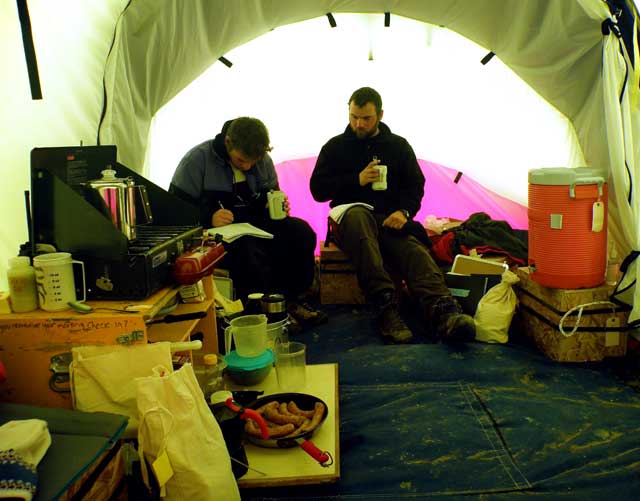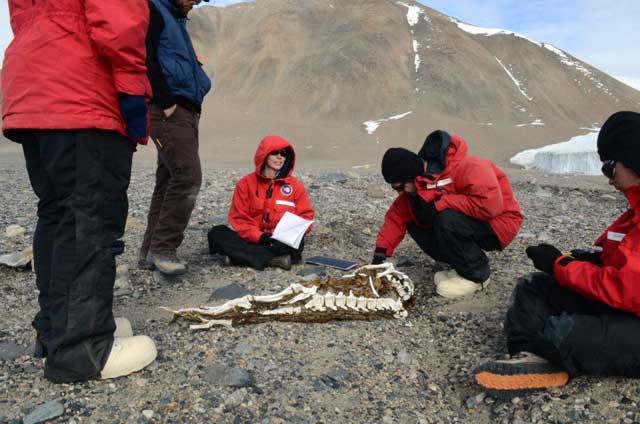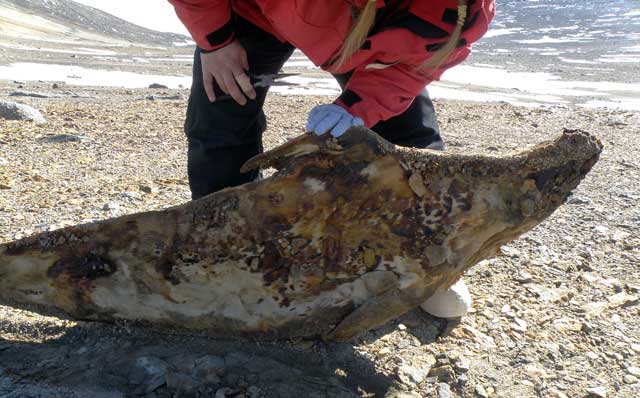|
Page 2/2 - Posted February 14, 2014
DNA evidence from wayward seals may shed light on past climactic conditionsAncient DNA preserved in the mummified corpses can provide details about the population size and diversity. Different isotopes of various elements, particularly nitrogen and carbon, can provide details on diet. The latter is based on the idea that you are what you eat. In this case, the seals would have absorbed carbon and nitrogen isotopes of their prey. The ratio of those isotopes would remain in any tissue samples. For example, nitrogen isotope ratios indicate how far up or down an animal feasts on the food web. The rare Nitrogen-15 isotope becomes more concentrated at higher trophic levels, so that scientists would be able to determine if crabeater seals, for instance, ate more fish in the past versus more krill today. What might the diet of ancient leopard seals reveal? “Even today, despite their reputation, leopards eat a surprising amount of krill,” Koch noted, referring to the tiny crustacean that is a keystone species in the Antarctic food web. And today it’s still unclear what caused the environment to change a millennium ago. The event roughly coincides with a cooling period in Europe known as the Little Ice Age, but there is much debate on whether there is a link between those events, according to Hall. It’s even possible, Koch and Hall noted, that ocean circulation may have fluctuated, forcing water only a few degrees above freezing to the surface, which would have melted sea ice. “It could be more of an ocean-driven phenomenon,” Koch said. What the researchers are finding might help test that theory, Hall added. In fact, many of the glaciers near McMurdo Station are retreating today. Not on the scale seen in West Antarctica or Greenland, but a few hundred meters in recent decades. “As they’re retreating, they’re revealing elephant seals. It’s returning to a glacial configuration that existed before,” Hall said. The ice also helped preserve the elephant seal mummies and other remains, some 7,000 years old. The freeze-dried, fragile bodies found in the McMurdo Dry Valleys aren’t nearly as old – maybe 2,000 years at the far end of the scale. 
Photo Courtesy: Paul Koch
Scientists Jon Nye and Scott Braddock enter data after a day of fieldwork.
“Mummies exposed on the surface break down very fast,” Koch said. “They blow apart in the wind.” Jonathan Nye, a former undergraduate under Koch, is working on a project to establish a scale that measures the rate at which the carcasses degrade and turn back into dust based on previous research. “We went out and tried to classify what we found based on the scale,” he explained. “It’s fairly linear.” Bone fragments offer the best chance to find older material, Koch added. Actually locating the mummified seals turned out to be relatively easy – and sometimes quite startling. Some of the animals managed to work their way 20 kilometers or more inland, across “impossible terrain” that required the scientists to hike over glaciers. “Some of them did go over the rocks, and you find a lot of them at dead ends, which is pretty sad,” Hall said. “You go up to the glacier margin or to a cliff and you’re almost certain to find seals. …They got there and that was it.” Koch said it’s unclear what drove the seals to what amounts to certain death. The Dry Valleys, with just a few ice-covered lakes and ephemeral streams, are devoid of water. Life there is on the microscopic scale – worm-like nematodes and bacteria. In the end, it could just be happenstance. “It could just be noise and represent a small fraction of the population,” Koch said. “It may just be that one or two seals per year walked the wrong way.” The researchers, however, hope they’re on the right track to understanding the region’s past environment and ecology thanks to a few wayward seals. NSF-funded research in this story: Paul Koch, Daniel Costa, Rus Hoelzel, University of California, Santa Cruz, Award No. 1142108 |
"News about the USAP, the Ice, and the People"



For USAP Participants |
For The Public |
For Researchers and EducatorsContact UsU.S. National Science FoundationOffice of Polar Programs Geosciences Directorate 2415 Eisenhower Avenue, Suite W7100 Alexandria, VA 22314 Sign up for the NSF Office of Polar Programs newsletter and events. Feedback Form |



